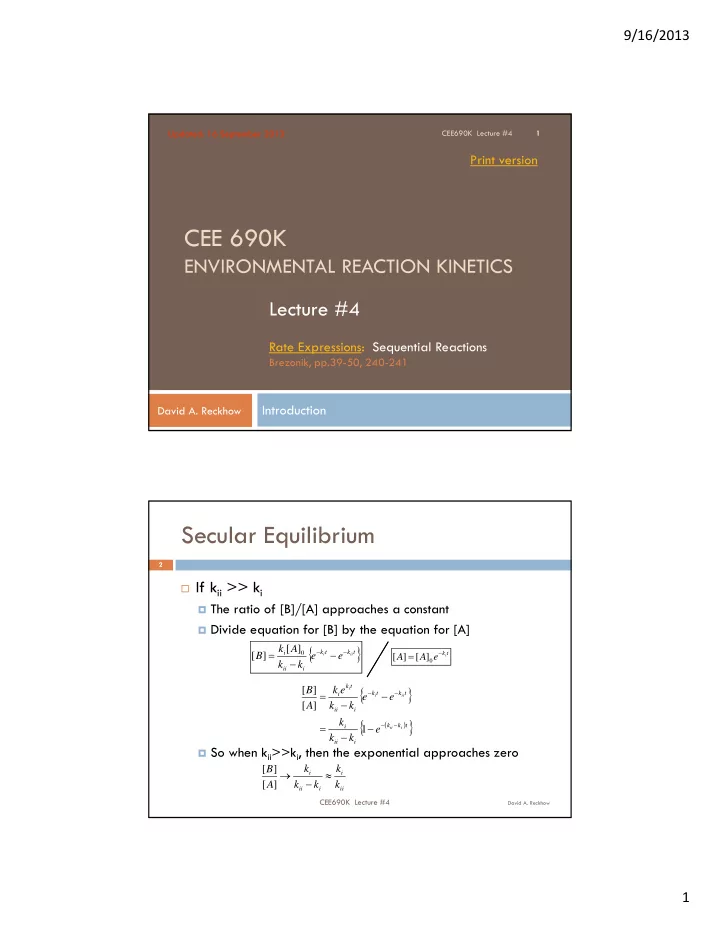

9/16/2013 Updated: 16 September 2013 CEE690K Lecture #4 1 Print version CEE 690K ENVIRONMENTAL REACTION KINETICS Lecture #4 Rate Expressions: Sequential Reactions Brezonik, pp.39-50, 240-241 Introduction David A. Reckhow Secular Equilibrium 2 If k ii >> k i The ratio of [B]/[A] approaches a constant Divide equation for [B] by the equation for [A] k [ A ] i 0 k t k t [ B ] e e k i t i ii [ A ] [ A ] e 0 k k ii i k t [ B ] k e i i k t k t e e i ii [ ] A k k ii i k k k t i 1 e ii i k k ii i So when k ii >>k i , then the exponential approaches zero [ B ] k k i i [ A ] k k k ii i ii CEE690K Lecture #4 David A. Reckhow 1
9/16/2013 Example: Radium decay I 3 Natural 226 Ra decays as follows: 226 k 222 k 218 Ra Rn Po i ii t 1/2 =1620 yr t 1/2 =3.8 d k i =4.28x10 -4 yr -1 k i =6.6x10 +1 yr -1 Radon is used as tracer for vertical mixing from sediments to water column; Ra is mostly in sediments Procedure: Collect water column sample & measure purged Rn Allow sample to reach secular equilibrium and again measure purged Rn Difference is used to calculate amount of Rn diffused from sediments Ra Rn Ra CEE690K Lecture #4 David A. Reckhow Ra Rn Radium decay II 4 How long to wait for secular equilibrium? [ B ] k k k t i 1 e ii i [ A ] k k ii i 4 [ Rn ] 4 . 28 x 10 4 66 4 . 28 x 10 t 1 e 4 % [ Ra ] 66 4 . 28 x 10 66 t 0 . 0000065 1 e % of equilibrium value = 100%(1-e -66t ) 92% at 14d 98% at 21d CEE690K Lecture #4 David A. Reckhow 2
9/16/2013 Chain Reactions I 5 Description A multi-step reaction mechanism where the reactants form intermediates that react with more reactants that yield products plus more intermediates Quite common for free radical reactions Three stages Initiation (I) - initiators Propagation (P) - promotors Termination (T) - scavengers Evidence Induction period Unusual catalysis or repression Strange rate equations (product in denominator, fractional order) Unusual surface effects CEE690K Lecture #4 David A. Reckhow Chain Reactions II 6 Simple Generic Cycle “A” and “B” are reactive intermediates, or chain carriers A 2 A 2 A B P B 2 ½ A 2 B A P A 2 A B 2 P A 2 2 B 2 P A 2 B CEE690K Lecture #4 David A. Reckhow 3
9/16/2013 Chain Reactions 7 CEE690K Lecture #4 David A. Reckhow Kinetic Modeling 8 In-class use of Scientist Consecutive 2 nd order reactions // Example - A --> B --> C Kinetics // This model describes a system having a second order conversion from A to B. // B is subsequently converted to C by another second order reaction. IndVars: TIME DepVars: A, B, C, D Params: A0, D0, KAB, KBC, A' = -KAB*A*D D' = -KAB*A*D-KBC*B*D B' = KAB*A*D - KBC*B*D C' = KBC*B*D // Initial Conditions TIME = 0.0 A = A0 D = D0 B = 0.0 CEE690K Lecture #4 David A. Reckhow C = 0.0 4
9/16/2013 9 To next lecture CEE690K Lecture #4 David A. Reckhow 5
Recommend
More recommend